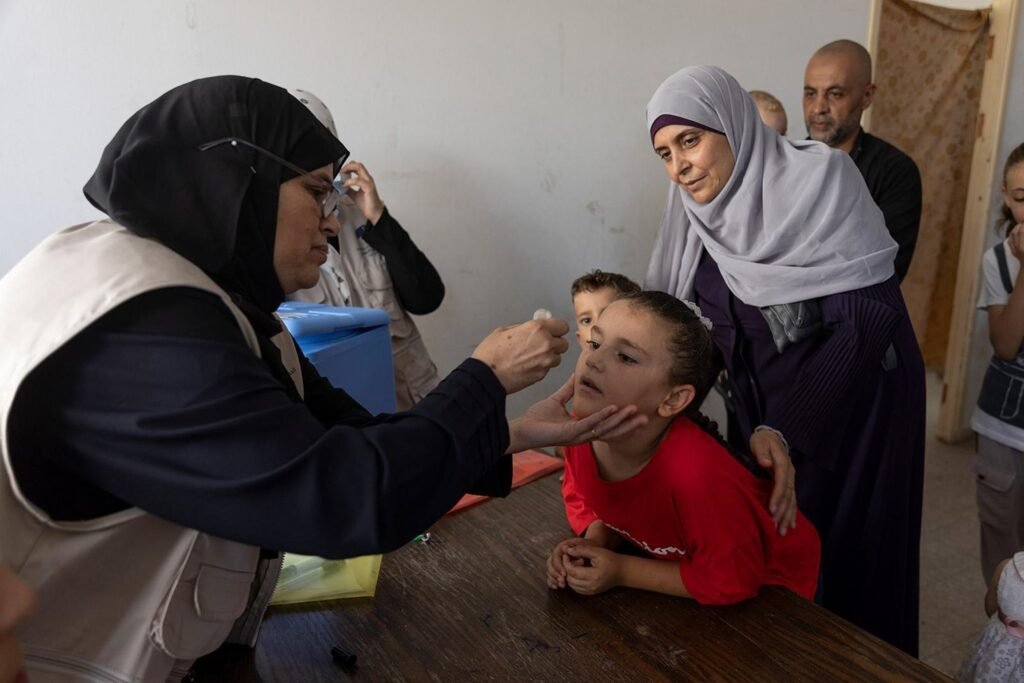“More than 500,000 children have been vaccinated following paralysis and polio outbreaks.”
A second round of polio vaccines is being provided to children in Gaza after 560,000 people received first doses in early September. The emergency campaign was launched to prevent the spread of polio following the detection of a virus known as circulating variant poliovirus type 2 (cVDPV2).
Polio-free in Gaza for 25 years Polio vaccination coverage was 99% until the conflict escalated Poliovirus was detected this summer Displaced people, health services disrupted, and extremely difficult living conditions for children Polio vaccination is being carried out in Gaza. © WHO, reproduced with permission.
Although the Gaza Strip had been polio-free for 25 years, cVDPV2 was detected in six environmental or wastewater samples collected in June 2024. There have been four pediatric cases of acute flaccid paralysis (AFP), one of which was confirmed to be infected. A child with polio infection tested positive for circulating variant poliovirus type 2 (cVDPV2).
According to the World Health Organization (WHO), Gaza had high levels of vaccination across the population until fighting escalated in October 2023.
This region is one of the most difficult regions in the world to implement public health interventions. The population density is very high, many people have been displaced, living conditions have been described by authorities as “deplorable”, and health, water and sanitation systems have been disrupted by the conflict in Gaza. Nevertheless, the vaccine rollout has exceeded expectations of international organizations.
Dr Richard Pieperkorn, WHO Director-General, said: “Despite the terrible conditions they have endured over the past 11 months, thanks to the support of resilient families and brave health workers, thousands of children have received the polio vaccine. It’s very reassuring to see that.” Representative of the occupied Palestinian territories. “All parties respect the humanitarian moratorium and look forward to this positive momentum continuing.”
Displaced Palestinians in Khan Yunis refugee camp, Gaza © WHO, reproduced with permission.
The first phase of the campaign was carried out by 513 teams of more than 2,180 health and community service workers. Vaccinations will be carried out in key public gathering spaces such as hospitals, medical hubs, primary care centres, camps where displaced people live, temporary learning spaces, food and water distribution points and transport routes from the central region to the north and north143 provided at a fixed location. Southern Gaza.
In addition, mobile teams visited tents and hard-to-reach locations to ensure families unable to visit fixed locations could be reached. A significant number of children targeted for vaccination were unable to go to the vaccination sites due to insecurity, resulting in a large number of children in Al Maghazi, Al Bureiji and Al Bureiji, located just outside the humanitarian moratorium agreement area. A special mission to the Musadel region was required.
The vaccination campaign is being carried out by the Palestinian Ministry of Health (MOH) in collaboration with the World Health Organization (WHO), the United Nations Children’s Fund (UNICEF), the United Nations Relief and Works Agency for Palestine Refugees (UNRWA), and others. partner.
After the first vaccinations were administered in early September, UNICEF Special Representative for Palestine, Jan Gough, said the campaign was designed to “safely and effectively protect children in the Gaza Strip and neighboring countries from the life-altering poliovirus.” “We will protect it.”
“While progress in this first round is encouraging, the work is not done yet. We are ready to complete the mission and ensure that in the next round, for the benefit of children around the world. I appeal to all concerned to complete this.”
background
On July 16, 2024, wastewater testing confirmed the detection of cVDPV2 in six samples collected on June 23, 2024 from the Khan Yunis and Deir al-Balah ES sites in the Gaza Strip. Further sequence analysis confirmed that these cVDPV2 isolates are related to a mutant poliovirus strain last detected in Egypt in 2023.
cVDPV2 is widespread within the Gaza Strip and internationally, given gaps in child immunity due to disruptions in routine vaccinations, disrupted health systems, permanent population displacement, malnutrition, and severely damaged water and sanitation systems. The risk of doing so remains high. The situation also increases the risk of spreading other vaccine-preventable diseases such as measles, as well as diarrhea, acute respiratory infections, hepatitis A, and childhood skin diseases.
Related articles
Olympic glory? Another gold medal this summer July 26, 2024
Global vaccination: disease outbreaks in countries with ‘zero doses’ of children April 25, 2023

